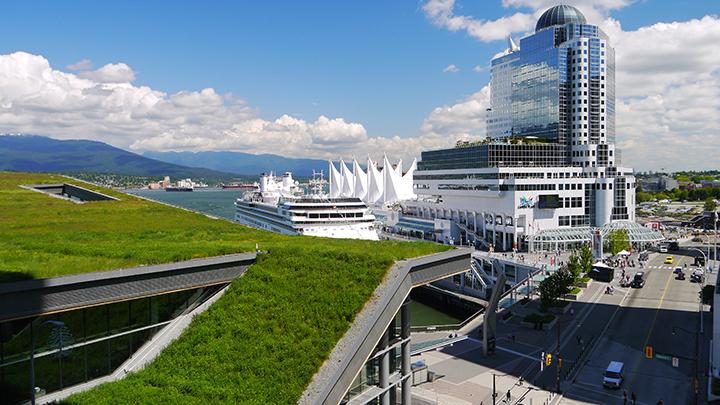Arbour Trails: Memory Grove in Fort Langley
Arbour Day 2018 was celebrated on April 27.
What is Arbour Day? It's a day to plant trees! The idea to hold an annual observance celebrating trees and promoting their planting and care originated in Nebraska, with pioneer and nature lover Julius Sterling Morton. The editor of the state’s first newspaper, he encouraged others to fill the once bare area with trees to provide shade, keep soil in place, and to use as fuel and building material.
This year on Arbour Day, a new grove of trees was planted in Fort Langley. “It’s intended to leave a bit of a legacy,” said Kurt Alberts, one of the organizers of the effort.
With the trees on Glover Road nearing a century in age, Alberts said the members of the Arbour Trails group wanted to create that kind of long-lasting legacy.
“I think that’s one of the character-defining elements of Fort Langley, those horse chestnut trees,” said Alberts. “We wanted to give personalities to the trees so everyone who sponsored a tree was asked to select a name.”
Alberts said the inspiration to build on that legacy goes back to a meeting he had with Dr. Marr’s son, Bill Marr, a number of years ago. Bill, who passed away at the age of 100 in February, was only four-years-old when his father planted the heritage trees.
“It was a feel-good project,” Alberts said, one that brought the community together. Alberts said pulling off such an ambitious legacy project required a lot of volunteers and businesses to come together. “It’s one thing to have an idea, but its one thing to actually make it happen,” Alberts said. “The dollars are pretty significant.”
If it wasn’t for the success of the Grove fund-raising gala on April 19, “We wouldn’t have been able to pull this off,” Alberts said. Alberts estimated the cost at about $50,000, not including the pro bono efforts of Mark van der Zalm, whose landscaping company donated staff and time.
Van der Zalm, who was MC at the opening, said the Grove would provide “a node on the trail where people can stop and rest for a moment.” Township Mayor Jack Froese called it a “very special project” that will benefit future generations “It’s great to see this grove come to life” Froese said.
Considering the importance of both native and non-native species to the historical development of Langley, a new mixed grove of trees was planted on April 27 of 17 Horse Chestnuts, 2 Western Red Cedars and 11 Grand Fir.
One of those Horse Chestnuts is Denbow's tree and is named "Faith".
Bill Boesterd, Denbow's President says "July 1st it was 37 years from the actual date we started business. As I look back, faith in our gracious God as a faithful provider of resources, people, opportunities and much more, has allowed me to stand, optimistically looking forward, in quiet peaceful confidence. Thus, as I thought of our tree, as she allows her roots to deepen into the sustaining foundation of her Creator, standing taller and stronger day by day, she will enjoy the gentle breeze and withstand the winds of adversity. Her name is Faith."
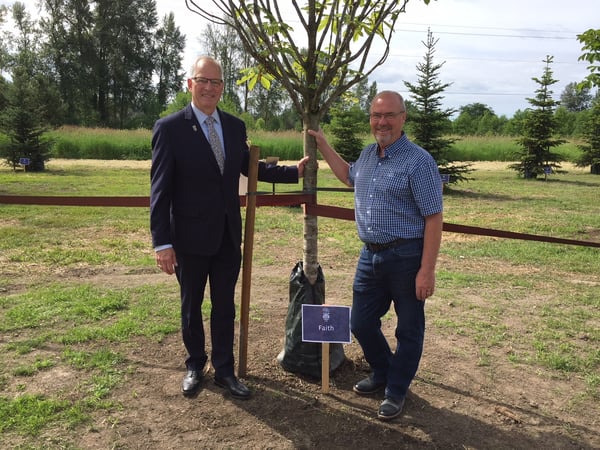
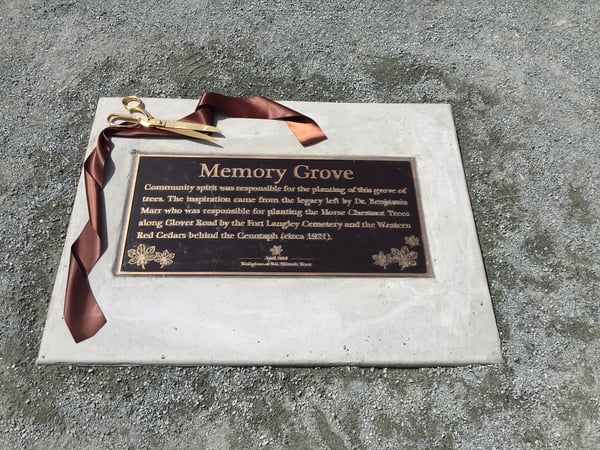
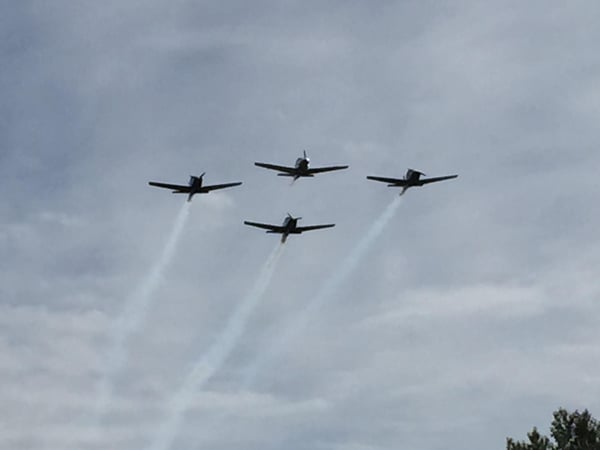
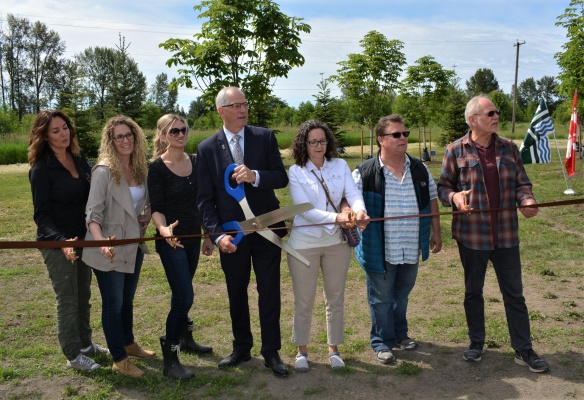
--
So, what is the background and importance of Horse Chestnuts in the Fort Langley area? It's an interesting history:
HORSE CHESTNUTS ON GLOVER
Street Trees Planted by Langley’s First Resident Doctor
In 1921 Bill Marr was four years old when his father, Dr. Benjamin Marr, planted the Horse Chestnut trees on Glover Road in front of the Marr house (now Little White House) in Fort Langley.
On the west side of Glover there are 17 Horse Chestnuts (along the cemetery) and on the east side 7 Horse Chestnuts are alternated with Western Red Cedars. Dr. Marr, Langley’s first resident physician, had a passion for gardening, and was responsible for planting of the street trees, as well as, Rhododendrons in the cemetery.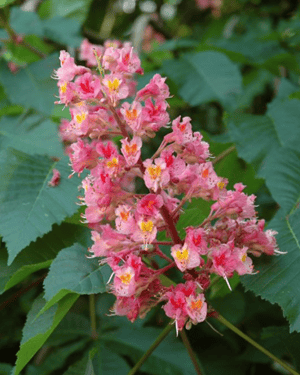
According to Bill, his father got the Horse Chestnuts from Walter Wilkie’s place where there were two huge trees on Glover in front of a circular driveway and the Wilkie home, just south of the Coulter Berry store.
Now, almost 100 years old, the Horse Chestnut trees are part of the heritage character of Fort Langley.
Dr. Butler Benjamin Marr
Langley’s first resident doctor arrived in Fort Langley in 1910 as a physician with the Canadian Northern Railway. Dr. Butler Benjamin Marr was one of the principal doctors with his practice initially covering all of Langley Township, an area of 120 square miles, with many of his patients served by house calls Dr. Marr enlisted in the Canadian Army in August 1914 and was initially posted overseas as a field officer in the Cavalry and then served in the Army Medical Corps. Upon his return in 1919, he resumed his practice in Fort Langley and was instrumental in establishing many wartime service organizations.
Dr. Marr was active in the Fort Langley Improvement Society, was a charter member of the Langley Board of Trade, a member of the Langley Fair Board, the Dyking Commission, Langley Elks Lodge, Eureka Masonic Lodge, Langley Conservation Society, the first president of the Langley Branch of the Great War Veterans’ Association (Royal Canadian Legion) as well as many other community organizations including Chairman of the Fort Preservation Committee.
In 1929, the Langley Branch of the Legion asked Dr. Marr to lead a committee to investigate the building of a “cottage hospital” in Langley. He continued his practice until his retirement in 1936. For many years, he championed the need for a hospital in Langley but, sadly, suffered a heart attack in 1939 and died at age 57. While he never saw the opening of Langley Memorial Hospital in 1948, Dr. Marr, along with many others, can be credited for bringing medical care to the early residents of Langley.
Dr. Marr’s passion for gardening left a legacy of Horse Chestnuts on Glover Road in Fort Langley.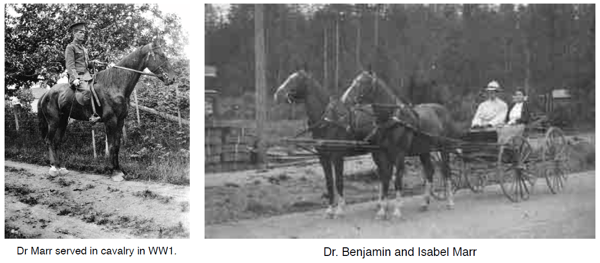
Horse Chestnut Trees in the Cemetery
Dr. Marr and his wife Isabel are buried in the Fort Langley cemetery. Both Marr and his wife were very community-minded and involved in a wide variety of organizations. As returning soldiers, Dr. Marr and Archie Payne led the campaign to fund the cenotaphs at the Murrayville and Fort Langley Cemeteries. Both monuments were unveiled in April 1921. The stone cenotaph in Fort Langley is located at the front of the veterans’ section of the cemetery.
The rows of Horse Chestnut trees on both sides of Glover Road in front of the Fort Langley Cemetery were planted by Dr. Marr. Some of the oldest rhododendrons in the cemetery were also planted by Marr. There is also a row of younger Horse Chestnuts in the western area of the cemetery.
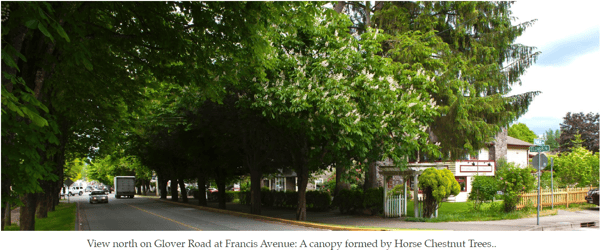
ARBOUR TRAILS INITIATIVE
Community Involvement in the Planting of Trees
The Arbour Trails initiative has objectives similar to an arboretum by recognizing and growing a diverse range of both native and non-native tree species that can be viewed for their natural beauty and utilized for learning, recreation, and to promote energy and storm water conservation efforts. The intent, in this case, is to use the trail system to identify the variety of trees throughout the community and enhance our education about different species, native/non-native. And by getting the community involved in the planting of trees, for example, on Arbour Day, appreciation of nature is enhanced.
Rationale for Memory Grove
With the trees on Glover Road near the cemetery now almost 100 years old, it’s a good time to think about the next 100 years and plant trees in that spirit. The use of Horse Chestnuts as street trees has challenges due to hydro pruning. A solution and discussion with Hydro and the Township is necessary to explore the replanting of this
boulevard. Horse Chestnuts would fair much better without the constant pruning.
Finding a Location to Plant a Grove of Trees
The recent addition of the Bedford Landing neighbourhood to Fort Langley also provided the community with approximately 40 acres of public open space in the form of the Fort to Fort linear park and the Salmon River Natural Area. The Salmon River Natural Area was donated to the community for public use and is connected to the rest of the village and its history by an extensive trail network. About twelve acres were previously farmed for corn and hay. Some trees have been planted within what is now old field habitat. Additional plantings are possible.
The Salmon River Natural Area
The conservation area donated to the municipality as part of the Bedford Landing development is approximately 35 acres in size. Located beside the Salmon River. the area has some old field habitat but is mostly in bush with swampy sections aided by beavers. Approximately twelve acres would be ideal for tree planting. The triangle highlighted in the map below is one half acre in size where a approximately 30 trees could be planted making a significant grove and legacy. A perfect site had been identified for the planting of a grove of trees.
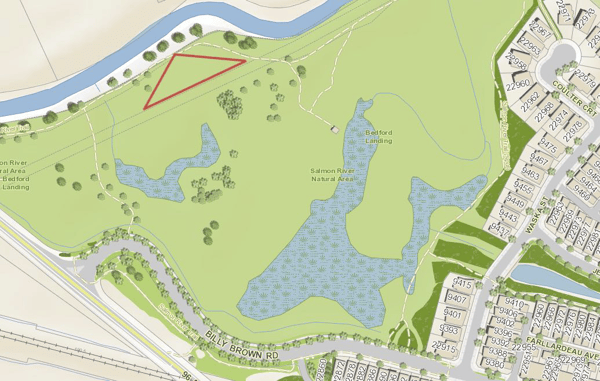
Map of the Salmon River Natural Area with tree planting site of one half acre shown in red outline.
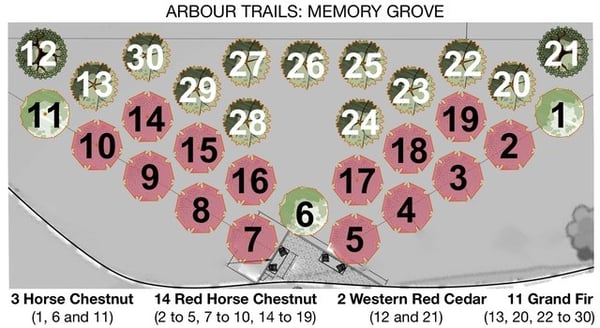
Denbow is excited to be a part of this conservation program. Our Horse Chestnut is tree #6 on the diagram above. We invite you to walk the Fort to Fort trail, find "Faith" and take time to rest in Memory Grove!
Sources: The Memory Grove website, and Fort Langley Times article by Dan Ferguson

